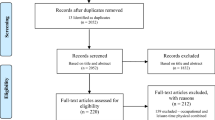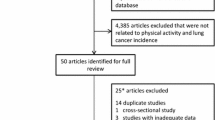Abstract
Purpose
Although evidence has accumulated that recreational physical activities (PA) may reduce lung cancer risk, there is little evidence concerning the possible role of a potentially more important source of PA, namely occupational PA. We investigated both recreational and lifetime occupational PA in relation to lung cancer risk in a population-based case–control study in Montreal, Canada (NCASES = 727; NCONTROLS = 1,351).
Methods
Unconditional logistic regression was used to estimate odds ratios (OR), separately for men and women, adjusting for smoking, exposure to occupational carcinogens, and sociodemographic and lifestyle factors.
Results
In both sexes, increasing recreational PA was associated with a lower lung cancer risk (ORMEN = 0.66, 95% confidence interval (CI) 0.47–0.92; ORWOMEN = 0.55, 95% CI 0.34–0.88, comparing the highest versus lowest tertiles). For occupational PA, no association was observed among women, while increasing occupational PA was associated with increased risk among men (ORMEN = 1.96, 95% CI 1.27–3.01). ORs were not modified by occupational lung carcinogen exposure, body mass index, and smoking level; results were similar across lung cancer histological types.
Conclusions
Our results support the previous findings for recreational PA and lung cancer risk. Unexpectedly, our findings suggest a positive association for occupational PA; this requires replication and more detailed investigation.
Similar content being viewed by others
Abbreviations
- PA:
-
Physical activity
- OR:
-
Odds ratio
- CI:
-
Confidence interval
- MET:
-
Metabolic equivalent of tasks
- CSI:
-
Comprehensive smoking index
- SD:
-
Standard deviation
- DAG:
-
Directed acyclic graphs
References
Parkin DM, Sasco AJ (1993) Lung cancer: worldwide variation in occurrence and proportion attributable to tobacco use. Lung Cancer 9:1–16
Abraham J, Gulley JL, Allegra CJ (2005) Bethesda handbook of clinical oncology. Lippincott Williams & Wilkins, Philadelphia
Friedenreich CM, MR Orenstein, (2002) Physical activity and cancer prevention: etiologic evidence and biological mechanisms. J Nutr 132(11 Suppl):3456S-3464S
Lee IM (2003) Physical activity and cancer prevention–data from epidemiologic studies. Med Sci Sports Exerc 35(11):1823–1827
Kruk J, Aboul-Enein HY (2006) Physical activity in the prevention of cancer. Asian Pac J Cancer Prev 7(1):11–21
Brenner DR et al (2016) Leisure-time physical activity and lung cancer risk: A systematic review and meta-analysis. Lung Cancer 95:17–27
Quadrilatero J, Hoffman-Goetz L (2003) Physical activity and colon cancer. A systematic review of potential mechanisms. J Sports Med Phys Fit 43(2):121–138
Csizmadi I et al (2011) Hours spent and energy expended in physical activity domains: results from the tomorrow project cohort in Alberta, Canada. Int J Behav Nutr Phys Act 8:110
Steindorf K et al (2006) Physical activity and lung cancer risk in the European prospective investigation into cancer and nutrition cohort. Int J Cancer 119(10):2389–2397
Rundle A et al (2010) Physical activity and lung cancer among non-smokers: a pilot molecular epidemiological study within EPIC. Biomarkers 15(1):20–30
Bak H et al (2005) Physical activity and risk for lung cancer in a Danish cohort. Int J Cancer 116(3):439–445
Colbert LH et al (2002) Physical activity and lung cancer risk in male smokers. Int J Cancer 98(5):770–773
Severson RK et al (1989) A prospective analysis of physical activity and cancer. Am J Epidemiol 130(3):522–529
Thune I, Lund E (1997) The influence of physical activity on lung-cancer risk: a prospective study of 81,516 men and women. Int J Cancer 70(1):57–62
Brownson RC et al (1991) Physical activity on the job and cancer in Missouri. Am J Public Health 81(5):639–642
Dosemeci M et al (1993) Occupational physical activity, socioeconomic status, and risks of 15 cancer sites in Turkey. Cancer Causes Control 4(4):313–321
Parent ME et al (2011) Occupational and recreational physical activity during adult life and the risk of cancer among men. Cancer Epidemiol 35(2):151–159
Leitzmann MF et al (2009) Prospective study of physical activity and lung cancer by histologic type in current, former, and never smokers. Am J Epidemiol. doi:10.1093/aje/kwn371
Steenland K, Nowlin S, Palu S (1995) Cancer incidence in the National Health and Nutrition Survey I. Follow-up data: diabetes, cholesterol, pulse and physical activity. Cancer Epidemiol Biomark Prev 4(8):807–811
Yun YH et al (2008) Dietary preference, physical activity, and cancer risk in men: national health insurance corporation study. BMC Cancer 8:366
Parent ME et al (2007) Exposure to diesel and gasoline engine emissions and the risk of lung cancer. Am J Epidemiol 165(1):53–62
Harrison RM, Smith DJ, Kibble AJ (2004) What is responsible for the carcinogenicity of PM2.5? Occup Environ Med 61(10):799–805
Ainsworth BE et al (2000) Compendium of physical activities: an update of activity codes and MET intensities. Med Sci Sports Exerc 32(9 Suppl):S498–S504
Anshell M, Freedson P, Haywood K (1991) Dictionary of the sports and exercise sciences, ed. H.K. Books, Champaign
Leffondre K et al (2006) Modelling smoking history using a comprehensive smoking index: application to lung cancer. Stat Med 25(24):4132–4146
Siemiatycki J et al (2004) Listing occupational carcinogens. Environ Health Perspect 112(15):1447–1459
Evans D et al (2012) Combining directed acyclic graphs and the change-in-estimate procedure as a novel approach to adjustment-variable selection in epidemiology. BMC Med Res Methodol 12:156
Royston P, Sauerbrie W (2008) Multivariable model—building: a pragmatic approach to regression analysis based on fractional polynomials for modelling continuous variables. John Wiley & Sons, West Sussex
Royston P, Altman DG (1994) Regression using fractional polynomials of continuous covariates: parsimonious parametric modelling. J Royal Stat Soc 43(3):429–467
WHO (1995) Physical status: the use and interpretation of anthropometry. Report of a WHO Expert Committee, WHO Technical Report Series 854. World Health Organization, Geneva
Kubik A et al (2008) A case–control study of lifestyle and lung cancer associations by histological types. Neoplasma 55(3):192–199
Mao Y et al (2003) Physical activity and the risk of lung cancer in Canada. Am J Epidemiol 158(6):564–575
Sinner P et al (2006) The association of physical activity with lung cancer incidence in a cohort of older women: the Iowa Women’s Health Study. Cancer Epidemiol Biomark Prev 15(12):2359–2363
Kukkonen-Harjula K (2007) Physical activity and cardiovascular health—work and leisure differ. Scandinavian J Work Environ Health 33(6):401–404
Karlqvist L, Leijon O, Harenstam A (2003) Physical demands in working life and individual physical capacity. Eur J Appl Physiol 89(6):536–547
Peake JM et al (2016) Recovery of the immune system after exercise. J Appl Physiol. doi:10.1152/japplphysiol.00622.2016
Pedersen BK, Rohde T, Ostrowski K (1998) Recovery of the immune system after exercise. Acta Physiol Scand 162(3):325–332
Grivennikov SI, Greten FR, Karin M (2010) Immunity, inflammation, and cancer. Cell 140(6):883–899
Schottenfeld DJF Fraumeni (2006) Cancer epidemiology and prevention 3rd ed. Oxford University Press, New York
Shephard RJ, Shek PN (1998) Associations between physical activity and susceptibility to cancer: possible mechanisms. Sports Med 26(5):293–315
Steindorf K et al (2005) Case–control study of lifetime occupational and recreational physical activity and risks of colon and rectal cancer. Eur J Cancer Prev 14(4):363–371
Friedenreich CM, Courneya KS, Bryant HE (2001) Influence of physical activity in different age and life periods on the risk of breast cancer. Epidemiology 12(6):604–612
Acknowledgments
This work was supported by the Canadian Cancer Society Research Institute (Grant #19912). Dr. Ho received a postdoctoral fellowship from the Canadian Institutes of Health Research and Lung Cancer Canada to conduct this work and is currently supported by the Cancer Research Society, Fonds de recherche du Québec–Santé (FRQS) and Ministère de l’Économie, de la Science et de l’Innovation du Québec (MESI). Dr. Parent received Career Investigator Awards from the FRQS. Dr. Abrahamowicz is a James McGill Professor. Dr. Siemiatycki holds the Guzzo Chair in Environment and Cancer. Dr. Koushik was supported by a New Investigator award of the Canadian Institutes of Health Research.
Author contributions
All authors contributed to this work.
Author information
Authors and Affiliations
Corresponding author
Ethics declarations
Conflict of interest
All authors declare that they have no conflict of interests.
Research involving human rights
All procedures performed in studies involving human participants were in accordance with the ethical standards of the institutional and/or national research committee and with the 1964 Helsinki declaration and its later amendments or comparable ethical standards.
Informed consent
Informed consent was obtained from all individual participants included in the study.
Electronic supplementary material
Below is the link to the electronic supplementary material.
Rights and permissions
About this article
Cite this article
Ho, V., Parent, ME., Pintos, J. et al. Physical activity and lung cancer risk in men and women. Cancer Causes Control 28, 309–318 (2017). https://doi.org/10.1007/s10552-017-0872-4
Received:
Accepted:
Published:
Issue Date:
DOI: https://doi.org/10.1007/s10552-017-0872-4




